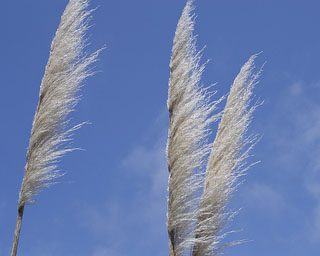 Cortaderia jubata. CDFW Photo by Jeb Bjerke.
Cortaderia jubata. CDFW Photo by Jeb Bjerke.
Pampas grass (Cortaderia selloana or Cortaderia jubata) is a quickly growing grass that forms massive clumps along roadsides, steep cliffs, river banks, and open areas that have been disturbed by human activities or natural disturbances. Introduced to Santa Barbara, California in 1848 by nursery operators, pampas grass has spread all over the state, threatening native plants and the animals that rely on them.
An individual pampas grass stand can produce millions of seeds annually that travel several miles, and because these grasses are very tolerant of intense sunlight, drought, and frost, they are very efficient at establishing in many habitat types. Due to the fact that pampas grass can live over a decade, it has become a favorable plant for people to grow in their gardens.
Invasive plants such as pampas grass displace native plants and create habitats that are lower in biodiversity. Furthermore, pampas grass has leaf blades that are highly undesirable as food or shelter to birds and other wildlife, and can actually cause physical harm to those animals, including humans, because the leaves are extremely sharp. Therefore, it is important that we do our part by not planting pampas grass in our gardens, but instead plant native plants that are comparably beautiful and provide the same utility.
Native Alternative
Giant wildrye (Elymus condensatus) is a grass that, like pampas grass, forms dense stands in a variety of different soils. It remains green year-round and is drought tolerant, but will also survive in regularly watered locations, meaning little maintenance is required to keep this grass looking great in your garden throughout the changing seasons. Giant wildrye has beautiful blue-gray or dark green leaves that are topped by clusters of yellow flowers during the summer and although this grass prefers full sunlight, it can also tolerate shady locations.
Unlike pampas grass, Giant wildrye is native to California and does not readily outcompete other native plants for resources such as space, light, and nutrients. It also spreads slowly compared to pampas grass, and therefore, it is much easier to contain within your garden fences. Furthermore, while pampas grass is not desirable to most animal species, Giant wildrye attracts various birds that enjoy their seeds.
Giant wildrye is a great native alternative to invasive pampas grass because it provides the same beauty and utility in your garden, but unlike pampas grass, it contributes to higher biodiversity and does not negatively impact the natural environment or those animal species that rely on it. Try out this native plant alternative in your garden today!